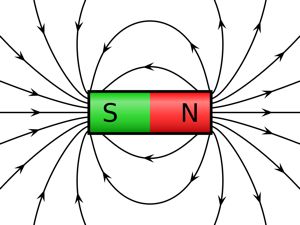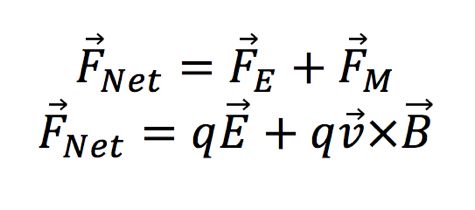Combining Electric and Magnetic Forces: Difference between revisions
No edit summary |
No edit summary |
||
| Line 1: | Line 1: | ||
Claimed by Alana Kaplan | Claimed by Alana Kaplan | ||
=='''Summary'''== | |||
When a charged particle is moving through a space with present electric and magnetic forces, if the forces are not balanced, the particles trajectory will change. It is important to remember that though the forces, observably, interact with a particle in different patterns, their effects can be quantitatively be compared. | When a charged particle is moving through a space with present electric and magnetic forces, if the forces are not balanced, the particles trajectory will change. It is important to remember that though the forces, observably, interact with a particle in different patterns, their effects can be quantitatively be compared. | ||
| Line 45: | Line 46: | ||
:::3) Your palm will face in the direction of the Magnetic Force | :::3) Your palm will face in the direction of the Magnetic Force | ||
===''Quantitative''=== | ==='''Quantitative'''=== | ||
The magnetic force on an object is: | |||
::[[File:ForceB.jpg]] | |||
Note that if the velocity and magnetic field are parallel the magnetic force is zero. | |||
=='''Electric and Magnetic Forces Combined'''== | |||
'''Magnetic | |||
The net force acting on a particle passing through a magnetic and electric field is: | The net force acting on a particle passing through a magnetic and electric field is: | ||
::[[File:Fnet.jpg]] | |||
This net force calculation is known as "Lorentz Force" | |||
When the net force is equal to zero, the velocity stays constant. The net force is equal when: | |||
As seen in '''Figure 4''' , when the net forces acting on a particle are balanced the electric field, magnetic field, and velocity vector are all perpendicular to each other. The electric and magnetic forces are equal but opposite. | As seen in '''Figure 4''' , when the net forces acting on a particle are balanced the electric field, magnetic field, and velocity vector are all perpendicular to each other. The electric and magnetic forces are equal but opposite. | ||
Revision as of 15:02, 5 December 2015
Claimed by Alana Kaplan
Summary
When a charged particle is moving through a space with present electric and magnetic forces, if the forces are not balanced, the particles trajectory will change. It is important to remember that though the forces, observably, interact with a particle in different patterns, their effects can be quantitatively be compared.
Electric Forces
Qualitative
- • A particle being acted upon by an electric force will move in a straight line, in the path, or negative path depending on charge, of the the electric field line (See Figure 1) .
- • Electric fields point in a direction radially outward/ inward of a charged particle. There are four possible scenarios for the interaction of 2 charged particles:
- 1) A (-) charged Particle(1) is acting on a (-) charged particle(2)
- • Particle(2) feels force pointing radially outward from Particle(1)
- 2) A (+) charged Particle(1) is acting on a (-) charged particle(2)
- • Particle(2) feels force pointing radially inward toward Particle(1)
- 3) A (-) charged Particle(1) is acting on a (+) charged particle(2)
- • Particle(2) feels force pointing radially inward toward Particle(1)
- 4) A (+) charged Particle(1) is acting on a (+) charged particle(2)
- • Particle(2) feels force pointing radially outward from Particle(1)
- 1) A (-) charged Particle(1) is acting on a (-) charged particle(2)
Quantitative
The electric force formula is as follows:
Magnetic Forces

Qualitative
- • The magnetic force on a charged particle is orthogonal to the magnetic field.
- • The particle must be moving with some velocity for a magnetic force to be present.
- • Particles move perpendicular to the magnetic field lines in a helical manner (See Figure 2)
- • To find the magnetic force, you can use the Right Hand Rule as follows (See Figure 3):
- 1) Thumb in direction of the velocity
- 2)Fingers in the direction of the magnetic field
- 3) Your palm will face in the direction of the Magnetic Force
Quantitative
The magnetic force on an object is:
Note that if the velocity and magnetic field are parallel the magnetic force is zero.
Electric and Magnetic Forces Combined
The net force acting on a particle passing through a magnetic and electric field is:
This net force calculation is known as "Lorentz Force"
When the net force is equal to zero, the velocity stays constant. The net force is equal when:
As seen in Figure 4 , when the net forces acting on a particle are balanced the electric field, magnetic field, and velocity vector are all perpendicular to each other. The electric and magnetic forces are equal but opposite.


